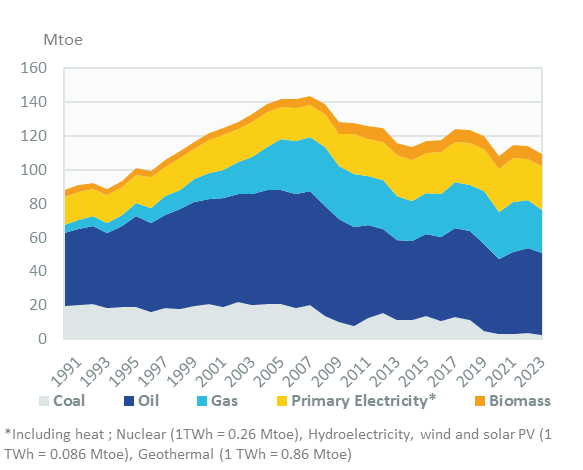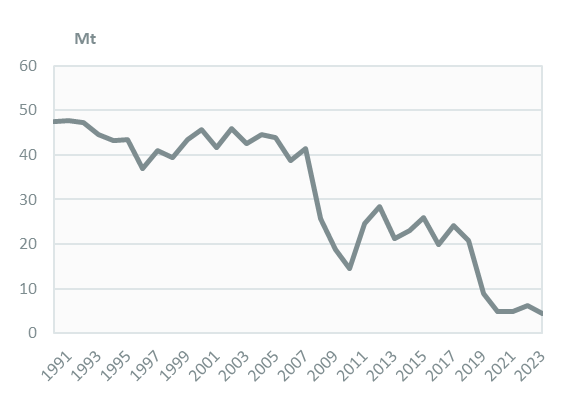-
-
 Energy and Climate Databases
Energy and Climate Databases- The most comprehensive and up-to-date annual energy database.
- Monitoring of technology providers in H2 supply chain.
- Monthly energy data on key energy markets.
- Monitoring of Hydrogen and Derivatives Projects
- The most reliable and up-to-date power generation database.
- The essentials of LNG trade at your fingertips.
- Global monitoring of new and existing refineries.
- Analyse energy consumption and efficiency trends at world level. Benchmark countries.
- Have your database developed by a recognised expert of both energy and IT.
-
 Energy - Climate Forecasts
Energy - Climate Forecasts- Future carbon costs with reliable price forecasts
- Instant access to energy and emissions forecasts.
- Annual projections of wholesale prices up to 2050, based on a 360° approach of the energy markets, enabled by the globally recognised POLES model.
- Wedges module showing a breakdown of the levers enabling to reduce emissions between two scenarios.
- Unique, independent projections of consumption by end-use.
- GHG Marginal Abatement Cost Curves.
- Benefit from proven models to draw your own energy scenarios and anticipate tomorrow’s challenges.
-
 Market Intelligence
Market Intelligence- 110 Energy and climate country reports.
- Tracking trends, EPCs, and national subsidy schemes for residential buildings.
- Daily brief covering the entirety of the turbine industry.
- A newsletter to receive the latest updates on evolving technologies and policies.
- Global energy news and analyses curated daily.
- Enerdata’s experts bring you the essentials about your market and competitors.
-
-
-
 Market Analysis
Market Analysis- Understanding key consumption trends and drivers across sectors.
- Granular and exclusive insight to address the most pressing business and strategic issues.
- Expertise in strategic and business intelligence, with fine-tuning to the market’s specificities.
-
 Energy - Climate Scenarios
Energy - Climate Scenarios- Providing the outlook of an energy commodity in mid to long term time horizons.
- Sector and driver specific energy demand forecasting.
- Assess the evolution of energy prices on the international and regional markets, as well as end-users prices.
- Enerdata guides you through pathways to reach climate targets.
- Supporting local authorities in their decarbonisation strategies.
-
 Climate Strategy and Policy Evaluation
Climate Strategy and Policy Evaluation- Cutting-edge quantitative tools and relevant indicators to monitor and evaluate evolutions on worldwide energy markets.
- Analysis of the most cost-effective options to reduce emissions.
- Quantified simulation and analysis of pledges for climate change negotiations.
- Breakdown of carbon markets and evaluation of the climate change impacts on the carbon price.
- Enerdata guides you on the most beneficial policy or investment options.
- Turning climate objectives into concrete action plans.
-
 Training
Training- Understand different policy targets and measures on energy efficiency.
- How to measure energy savings?
- Energy Forecasting is a 2 days training to learn to design and interpret energy forecasts.
- Energy statistics training allowing to create energy balance with supply, transformation and consumption and understanding the international energy statistics regulations.
- Initiation to EnerMED level 1is the training to approach on the most powerful energy demand forecasting model.
-
-
Resource Centre
Spain Key Figures
- Population:
- 48.8 million
- GDP growth rate:
- 3.15 %/year
- Energy independence:
- 32.9%
Data of the last year available: 2024
- Total consumption/GDP:*
- 64.4 (2005=100)
- CO2 Emissions:
- 4.12 tCO2/capita
- Rate of T&D power losses:
- 9.64%
* at purchasing power parity
View all macro and energy indicators in the Spain energy report
Spain Energy News
View all news, archive your new and create your own daily newsletters only on your topics/countries of interest with Key Energy Intelligence
Spain Energy Research
Benefit from up to 2 000 up-to-date data series for 186 countries in Global Energy & CO2 data
A data overview is available in the global energy statistics app
Spain Total Energy Production & Consumption
In 2024, total consumption per capita was 2.3 toe, including 4 700 kWh of electricity.
Graph: CONSUMPTION TRENDS BY ENERGY SOURCE (Mtoe)

Total energy consumption increased by 1% in 2024 (112 Mtoe), after having remained around the average growth since 2021 (0.8%/year). Previously, it had declined by 1.6%/year between 2017 and 2019. The 2008 crisis slashed energy consumption (-3.3%/year until 2014), which recovered rapidly between 2014 and 2017 (+3%/year).
Source: Spain energy report
Interactive Chart Spain Total Energy Production & Consumption
Source: Global Energy & CO2 data
Benefit from up to 2 000 up-to-date data series for 186 countries in Global Energy & CO2 data
View the detailed fondamentals of the market at country level (graphs, tables, analysis) in the Spain energy report
Spain Oil Production & Consumption
Oil production is negligible. Crude oil imports increased slightly - by 3% - in 2024, reaching 63.4 Mt, returning to its historical growth from 2010 to 2018. The main suppliers of crude in 2024 were the United States (16%), Brazil (14%), Mexico (13%), and Nigeria (11%).
Spain has 9 oil refineries with a total capacity of about 1.6 mb/d. Refined oil product production increased by 3% to 63 Mt in 2024, after a reduction in 2023 (-3%), following increases in 2022 and 2021 of 7% and 4%, respectively.
Source: Spain energy report
Interactive Chart Spain Crude Oil Production & Consumption
Source: Global Energy & CO2 data
Interactive Chart Spain Refined Oil Products Production & Consumption
Source: Global Energy & CO2 data
Benefit from up to 2 000 up-to-date data series for 186 countries in Global Energy & CO2 data
Additionally, for more detailed information on refineries, you can request a sample of our EMEA Refineries Dataset
Spain Natural Gas Production & Consumption
The country's gas consumption has decreased by 8%/year since 20232%, reaching 28 bcm in 2024 due to a 24%/year drop in power sector consumption. It increased by 6% in 2021 after having dropped by 10% in 2020. Gas consumption surged by 11%/year between 2000 and 2008 with the rapid development of CCGT capacities; it fell by 6%/year until 2014 in the wake of the economic crisis and then recovered until 2019 (+5.5%/year) as gas consumption in the power sector skyrocketed (+13%/year).
Source: Spain energy report
Interactive Chart Spain Gas Production & Consumption
Source: Global Energy & CO2 data
Benefit from up to 2 000 up-to-date data series for 186 countries in Global Energy & CO2 data
Additionally, for more detailed information on the LNG trade, you can request a sample of our EMEA LNG Trade Dataset
Spain Coal and Lignite Production & Consumption
Coal consumption decreased by 14% in 2024 to 3.7 Mt after a 25% increase in 2022. Historically, coal has seen a steady drop in consumption since 2016; the most dramatic fall was in 2019, with a 76% decrease.
Around half of the coal and lignite is used in the coal industry (46% in 2024), followed by power generation (38%) and industry (16%).
Graph: COAL CONSUMPTION (Mt)

Graph: COAL CONSUMPTION BREAKDOWN BY SECTOR (2024, %)
Source: Spain energy report
Interactive Chart Spain Coal and Lignite Production & Consumption
Source: Global Energy & CO2 data
Benefit from up to 2 000 up-to-date data series for 186 countries in Global Energy & CO2 data
View the detailed consumption trends at country level (graphs, tables, analysis) in the Spain energy report
Spain Power Production & Consumption
The country's electricity consumption increased marginally -by 1%- to 232 TWh in 2024, after two years with a declining trend (-1%/year) and a 3.5% increase in 2021. Previously, electricity consumption surged between 2000 and 2008 (+3.7%/year), dipped until 2014 (-1.8%/year), and recovered slightly until 2018 (+1.3%/year), before decreasing until 2020 (-8%, of which -6% in 2020).
The share of electricity in final energy consumption increased regularly from 18% in 1990 to 22.5% in 2010 and has remained stable since then (23% in 2024).
Graph: ELECTRICITY CONSUMPTION (TWh)
Source: Spain energy report
Interactive Chart Spain Power Production & Consumption
Source: Global Energy & CO2 data
Benefit from up to 2 000 up-to-date data series for 186 countries in Global Energy & CO2 data
View the detailed consumption trends at country level (graphs, tables, analysis) in the Spain energy report
Spain Renewable in % Electricity Production
The target set in the National Action Plan for Renewable Energies (PANER, 2010) for a share of renewables in final energy consumption of 22.7% in 2020 was missed by 1.5 points, with 21.2% achieved.
Under the NECP 2023-2030, Spain increased the share of renewables from the previous target of 42% to 48% of final energy consumption, of which 81% is for power (up from 74%) and 28% for transport (up from 25%). In 2023, renewables covered 25% of the final consumption (56.9% for electricity, 21.5% for heating and cooling, and 12% in transport).
Source: Spain energy report
Interactive Chart Spain Share of Renewables in Electricity Production (incl hydro)
Source: Global Energy & CO2 data
Benefit from up to 2 000 up-to-date data series for 186 countries in Global Energy & CO2 data
Learn more about renewables in the European Battery Market Analysis
Spain GHG emissions and CO2 emissions
GHG emissions decreased by 9% in 2023 to 219 MtCO2eq, after increasing by 8% in 2021 and by 2% in 2022; they fell by nearly 5%/year over 2007-2014, recovered until 2017, and then declined again until 2020 (-14% in 2020 alone).
According to the NECP 2023-2030, Spain aims to reduce its GHG gas emissions by 32% in 2030 compared to 1990 levels (70% emission reduction in ETS sectors and 43% in other sectors); in 2023, they were 13% below 1990 levels and 44% below 2005.
Source: Spain energy report
Interactive Chart Spain CO2 emissions
Source: Global Energy & CO2 data
Benefit from up to 2 000 up-to-date data series for 186 countries in Global Energy & CO2 data
View the detailed consumption trends at country level (graphs, tables, analysis) in the Spain energy report